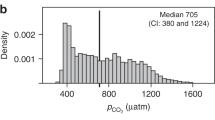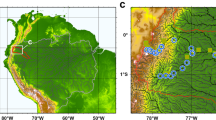Abstract
The evasion of carbon dioxide from inland waters was only recently included in assessments of the global carbon budget1,2,3. Present estimates of carbon dioxide release from global freshwater systems, including lakes and wetlands, range from 0.7 to 3.3 Pg C yr−1 (refs 1, 4, 5, 6, 7). However, these estimates are based on incomplete spatial coverage of carbon dioxide evasion, and an inadequate understanding of the factors controlling the efflux of carbon dioxide across large drainage networks6. Here, we estimate the amount of carbon degassed from streams and rivers in the United States using measurements of temperature, alkalinity and pH, together with high-resolution data on the morphology and surface area of these waterways. We show that streams and rivers in the US are supersaturated with carbon dioxide when compared with the atmosphere, emitting 97±32 Tg carbon each year. We further show that regionally, carbon dioxide evasion from streams and rivers is positively correlated with annual precipitation, which we attribute to climatic regulation of stream surface area, and the flushing of carbon dioxide from soils. Scaling our analysis from the US to temperate rivers between 25° N and 50° N, we estimate a release of around 0.5 Pg carbon to the atmosphere each year.
This is a preview of subscription content, access via your institution
Access options
Subscribe to this journal
Receive 12 print issues and online access
$259.00 per year
only $21.58 per issue
Buy this article
- Purchase on Springer Link
- Instant access to full article PDF
Prices may be subject to local taxes which are calculated during checkout



Similar content being viewed by others
References
Battin, T. J. et al. The boundless carbon cycle. Nature Geosci. 2, 598–600 (2009).
Pacala, S. et al. in The First State of the Carbon Cycle Report (SOCCR): The North American Carbon Budget and Implications for the Global Carbon Cycle. A Report by the US Climate Change Science Program and the Subcommittee on Global Change Research (eds King, A. W. et al.) 29–36 (National Oceanic and Atmospheric Administration, National Climate Data Center, 2007).
Solomon, S. IPCC Climate Change 2007 : The Physical Science Basis (Cambridge Univ. Press, 2007).
Tranvik, L. J. et al. Lakes and reservoirs as regulators of carbon cycling and climate. Limnol. Oceanogr. 54, 2298–2314 (2009).
Aufdenkampe, A. K. et al. Riverine coupling of biogeochemical cycles between land, oceans, and atmosphere. Front Ecol. Environ. 9, 53–60 (2011).
Cole, J. J. et al. Plumbing the global carbon cycle: Integrating inland waters into the terrestrial carbon budget. Ecosystems 10, 171–184 (2007).
Sabine, C. L. et al. The oceanic sink for anthropogenic CO2 . Science 305, 367–371 (2004).
Dubois, K. D., Lee, D. & Veizer, J. Isotopic constraints on alkalinity, dissolved organic carbon, and atmospheric carbon dioxide fluxes in the Mississippi River. J. Geophys. Res. 115, G02018 (2010).
Johnson, M. S. et al. CO2 efflux from Amazonian headwater streams represents a significant fate for deep soil respiration. Geophys. Res. Lett. 35 (2008).
Jones, J. B. & Mulholland, P. J. Influence of drainage basin topography and elevation on carbon dioxide and methane supersaturation of stream water. Biogeoschemistry 40, 57–72 (1998).
Davidson, E. A., Figueiredo, R. O., Markewitz, D. & Aufdenkampe, A. K. Dissolved CO2 in small catchment streams of eastern Amazonia: A minor pathway of terrestrial carbon loss. J. Geophys. Res. 115, G04005 (2010).
Zappa, C. J. et al. Environmental turbulent mixing controls on air–water gas exchange in marine and aquatic systems. Geophys. Res. Lett. 34, L10601 (2007).
Alin, S. R. et al. Physical controls on carbon dioxide transfer velocity and flux in low-gradient river systems and implications for regional carbon budgets. J. Geophys. Res. 116 (2011).
Jones, J. B. & Mulholland, P. J. Carbon dioxide variation in a hardwood forest stream: An integrative measure of whole catchment soil respiration. Ecosystems 1, 183–196 (1998).
Mayorga, E. et al. Young organic matter as a source of carbon dioxide outgassing from Amazonian rivers. Nature 436, 538–541 (2005).
del Giorgio, P. A. & Pace, M. L. Relative independence of dissolved organic carbon transport and processing in a large temperate river: The Hudson River as both pipe and reactor. Limnol. Oceanogr. 53, 185–197 (2008).
Knapp, A. K. & Smith, M. D. Variation among biomes in temporal dynamics of aboveground primary production. Science 291, 481–484 (2001).
Turner, D. P. et al. Evaluation of MODIS NPP and GPP products across multiple biomes. Remote Sens. Environ. 102, 282–292 (2006).
Raymond, P. A., Oh, N-H., Turner, R. E. & Broussard, W. Anthropogenically enhanced fluxes of water and carbon from the Mississippi River. Nature 451, 449–452 (2008).
Yao, G. R. et al. Dynamics Of CO2 partial pressure and CO2 outgassing in the lower reaches of the Xijiang River, a subtropical monsoon river in China. Sci. Total Environ. 376, 255–266 (2007).
Richey, J. E., Melack, J. M., Aufdenkampe, A. K., Ballester, V. M. & Hess, L. L. Outgassing from Amazonian rivers and wetlands as a large tropical source of atmospheric CO2 . Nature 416, 617–620 (2002).
Rasera, M. D. F. L. et al. Small rivers in the southwestern Amazon and their role in CO2 outgassing. Earth Interact. 12, 6 (2008).
Humborg, C. et al. CO2 supersaturation along the aquatic conduit in Swedish watersheds as constrained by terrestrial respiration, aquatic respiration and weathering. Glob. Change Biol. 16, 1966–1978 (2010).
Bastviken, D., Tranvik, L. J., Downing, J. A., Crill, P. M. & Enrich-Prast, A. Freshwater methane emissions offset the continental carbon sink. Science 331, 50 (2011).
Sun, G. et al. Upscaling key ecosystem functions across the conterminous United States by a water-centric ecosystem model. J. Geophys. Res. 116, G00J05 (2011).
Raymond, P. A. et al. Controls on the variability of organic matter and dissolved inorganic carbon ages in northeast US rivers. Mar. Chem. 92, 353–366 (2004).
Raymond, P. A., Caraco, N. F. & Cole, J. J. Carbon dioxide concentration and atmospheric flux in the Hudson River. Estuaries 20, 381–390 (1997).
Zeng, F. W. & Masiello, C. A. Sources of CO2 evasion from two subtropical rivers in North America. Biogeochemistry 100, 211–225 (2010).
NHDPlus (US Environmental Protection Agency (USEPA) and the US Geological Survey (USGS), 2005).
Leopold, L. B. & Maddock, T. J., D.o.t. Interior (ed.) (United States Government Printing Office, Washington, 1953).
Acknowledgements
Financial support for this research was provided by a NASA Earth and Space Science Fellowship (NNX07AN83h), a NASA Carbon and Ecosystems Program grant (NNX11AH68G), an NSF-CAREER grant (NSF DEB-0546153) and the Yale School of Forestry and Environmental Studies. Continued research support is provided by the Yale Center for Earth Observation and the US Geological Survey, Climate and Land Use Change Mission, LandCarbon Project.
Author information
Authors and Affiliations
Contributions
D.B. and P.A.R. conceived and designed the analysis. D.B. carried out all computations and data analysis and wrote most of the manuscript. P.A.R. supervised the research, aided in interpretation of the data and helped write the manuscript.
Corresponding author
Ethics declarations
Competing interests
The authors declare no competing financial interests.
Supplementary information
Supplementary Information
Supplementary Information (PDF 2709 kb)
Rights and permissions
About this article
Cite this article
Butman, D., Raymond, P. Significant efflux of carbon dioxide from streams and rivers in the United States. Nature Geosci 4, 839–842 (2011). https://doi.org/10.1038/ngeo1294
Received:
Accepted:
Published:
Issue Date:
DOI: https://doi.org/10.1038/ngeo1294
This article is cited by
-
Water quality at the end of the Mississippi River for 120 years: the agricultural imperative
Hydrobiologia (2024)
-
A 30-year dataset of CO2 in flowing freshwaters in the United States
Scientific Data (2023)
-
Andean headwater and piedmont streams are hot spots of carbon dioxide and methane emissions in the Amazon basin
Communications Earth & Environment (2023)
-
River ecosystem metabolism and carbon biogeochemistry in a changing world
Nature (2023)
-
Groundwater discharge contribution to dissolved inorganic carbon and riverine carbon emissions in a subarctic region
Biogeochemistry (2023)



